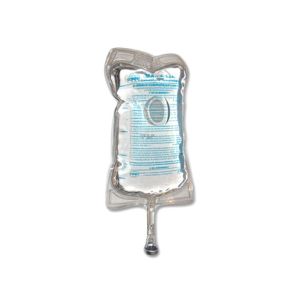NAME
SODIUM CHLORIDE SALF
PHARMACOTHERAPEUTIC CATEGORY
Intravenous solutions.
ACTIVE PRINCIPLES
Sodium chloride.
EXCIPIENTS
Water for injections.
INDICATIONS
Reintegration of fluids and sodium chloride.
CONTRAINDICATIONS / SECONDARY EFFECT
Hypernatremia; hydrosaline plethora.
DOSAGE
The medicinal product should be administered by intravenous infusion. >> Treatment of isotonic fluid depletion (extracellular dehydration). Adults and adolescents: from 500 ml to 3 liters in 24 hours. Infants and children (up to 12 years of age): from 20 to 100 ml in 24 hours and per kg of body weight, depending on age and total body weight. Dosage should be appropriately reduced in patients with renal insufficiency. Treatment of sodium deficiency: the dose is dependent on age, weight, clinical conditions, electrolyte and osmolarity, and is related to the calculated sodium deficit. The theoretical sodium deficit can be calculated using the following formula: DEFICIT (mEq) = (140 - P) x V. Using hypertonic solutions (2% - 3% - 5%), administer half the dose in the first 8 hours up to to a maximum of 100 ml / hour; then administer the remaining dose until a plasma sodium concentration of 130 mEq / l or until symptoms improve. In conditions of severe sodium depletion and in the treatment of severe symptoms related to chronic hyponatremia, administer hypertonic sodium chloride solutions in order to increase the plasma sodium concentration by 1-2 mmol / l / hour. Pay attention that the correction does not exceed 10-12 mmol / l in 24 hours and 18 mmol / l in 48 hours. In the event that the sodium chloride solutions, and in particular the 0.9% solutions, are used as diluting solutions for the intravenous administration of drugs that must be previously diluted, check in advance the compatibility of these drugs with sodium chloride and its concentration most suitable for administration in the SmPC of the drug to be diluted. If the concentration is not indicated, use the 0.9% solution.
STORAGE
Store in tightly closed container. Do not freeze or refrigerate. The solution should be clear, colorless and free from visible particles.
WARNINGS
Sodium salts should be administered with caution in patients with hypertension, heart failure, peripheral or pulmonary edema, impaired renal function, pre-eclampsia, or other conditions associated with sodium retention. Solutions with concentrations higher than 0.9% (hypertonic solutions) must be used with caution, at a controlled rate of infusion and only in cases where they are specifically prescribed. Use with great caution in patients with congestive heart failure, severe renal insufficiency and in clinical states where there is edema with salt retention; in patients being treated with corticosteroid or corticotropin drugs. Continuous administration without the addition of potassium may cause hypokalaemia. Use with caution in children. During the infusion it is good practice to monitor the fluid balance, electrolytes, plasma osmolarity and acid-base balance. The solution should be clear, colorless and free from visible particles. Use immediately after opening the container. The container is for one uninterrupted administration and any residue cannot be used.
INTERACTIONS
Corticosteroids are associated with sodium and water retention, resulting in edema and hypertension: therefore, caution should be exercised in the simultaneous administration of sodium salts and corticosteroids. Although sodium chloride is compatible with a large number of solutions and medicines, it is still advisable to check its compatibility in the SmPC of the medicine that you intend to co-administer.
SIDE EFFECTS
The following are the undesirable effects of sodium chloride, organized according to the MedDRA system organ class. There are insufficient data available to establish the frequency of the individual effects listed. Disorders of water and electrolyte balance: hypernatremia, hypervolemia, plasma hypoosmolarity (for 0.45% solutions), hyperchloremia (which can cause a loss of bicarbonates with consequent acidosis). Nervous system disorders: headache, dizziness, restlessness, fever, irritability, weakness, muscle stiffness, convulsions, coma, death. Psychiatric disorders: drowsiness, confusional states. Respiratory, thoracic and mediastinal disorders: dyspnoea, respiratory arrest. Gastrointestinal disorders: thirst, decreased salivation, nausea, vomiting, diarrhea, abdominal pain. Cardiac disorders: tachycardia. Eye disorders: reduced lacrimation. Renal and urinary disorders: renal failure. Vascular disorders: hypotension, hypertension, pulmonary and peripheral edema. General disorders and administration site conditions: Infusion site infection, local pain or reaction, venous irritation, thrombosis or venous phlebitis extending from the infusion site, extravasation.
PREGNANCY AND BREASTFEEDING
Although no effects on the development of the fetus have been highlighted, the medicine should be administered only in case of real need '. The medicine is compatible with breastfeeding.
